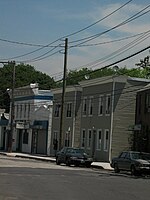Grant City, Staten Island
Neighborhoods in Staten Island

Grant City is the name of a neighborhood located on the East Shore of Staten Island, New York City. To the east of Grant City lies Midland Beach, and a high cliff to the west of Richmond Road separates Grant City from Todt Hill. New Dorp is situated immediately south of Grant City. Dongan Hills is situated to the north.
Excerpt from the Wikipedia article Grant City, Staten Island (License: CC BY-SA 3.0, Authors, Images).Grant City, Staten Island
Lincoln Avenue, New York Staten Island
Geographical coordinates (GPS) Address Nearby Places Show on map
Geographical coordinates (GPS)
| Latitude | Longitude |
|---|---|
| N 40.579166666667 ° | E -74.108055555556 ° |
Address
Lincoln Avenue 145
10306 New York, Staten Island
New York, United States
Open on Google Maps







